CO-96 Denial Code: Coding Non-Covered Charges & Bill Denial
One of the most frequent and often misunderstood is Denial Code CO-96, which indicates there is an uncovered service in the bill.

Did you know that in 2024, nearly 11.8% of all healthcare claims were initially denied, this is a steady increase of 2.55% from the previous year. Claim denials like these slow down reimbursements, create administrative backlogs, and cost the healthcare organizations thousands of dollars each and every month.
These issues will disrupt the revenue cycle making it harder for your teams to maintain consistent cash flow. To manage this growing issue effectively, providers must understand the reason behind each denial and what denials are.

Denial codes are codes your organization will receive when a bill has an error. The code number will tell your staff exactly what's wrong with the bill so it can be corrected. There are two main types of denial codes, there are CO codes which stands for ‘Contractually Obligated’.
This means that if a denial comes back it is on the insurance to fix the code and then make the agreed upon payment. The other code is a PR code,which stands for ‘Patient Responsibility’. This code sounds exactly what it is, once the bill is fixed the payment or payments fall on the patients shoulders.
One of the most frequent and often misunderstood is Denial Code CO-96, which indicates there is an uncovered service in the bill.
What is the Denial Code CO 96?
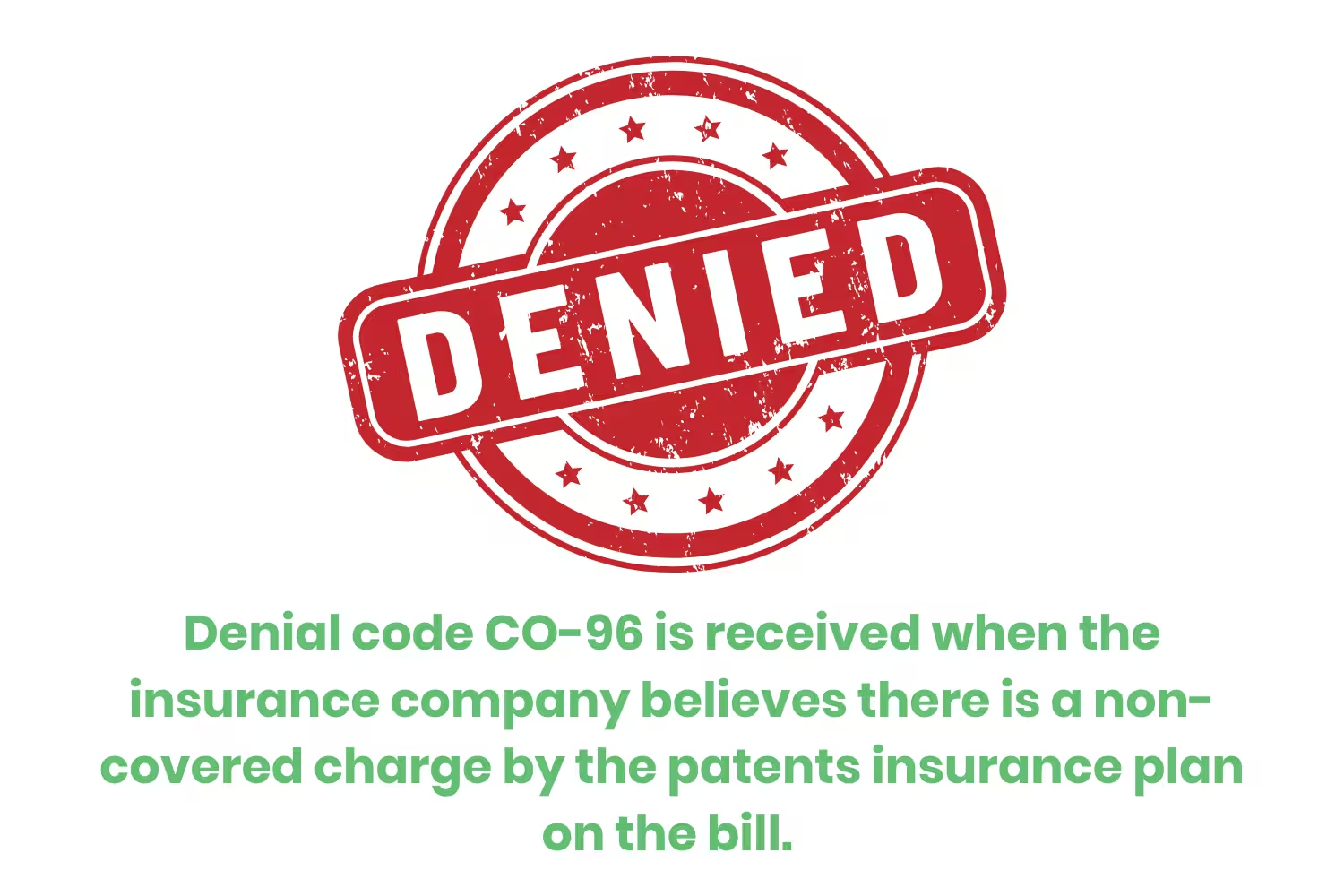
Definition of CO-96 Denial Code
Denial code CO-96 is received when the insurance company believes there is a non-covered charge by the patents insurance plan on the bill. In simpler terms the insurance company thinks the charge is someone else's problem and is denying making any sort of payment.
This code comes from the Claim Adjustment Reason Codes or (CARC system), which is a standardized list developed by the insurance industry to explain why a claim or service line was adjusted, reduced, or denied.
Each denial may also include a remark code, which can give additional information about the denial code and helps explain to your staff the payers explanations. These two resources are vital to making the resubmission process run smoothly and ensure payment is made as soon as possible.
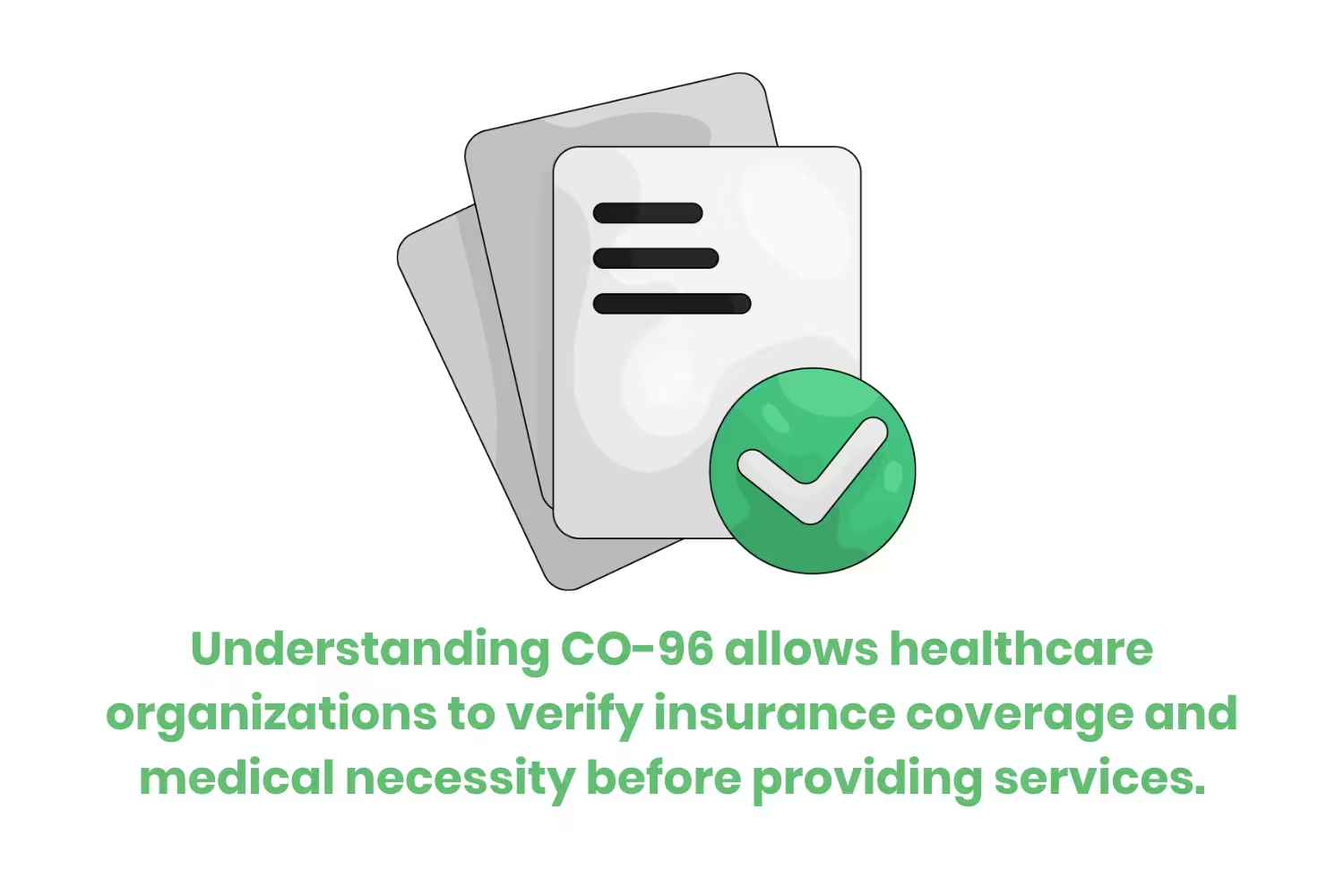
Importance in Medical Billing
Denial code CO-96 is important in medical billing because it directly impacts how and when providers get paid. When a healthcare provider receives this code, it indicates a coverage issue rather than a billing or documentation error. Recognizing it early helps billing teams avoid unnecessary appeals and identify whether a service falls outside the scope of the payers coverage policy.
Understanding CO-96 allows healthcare organizations to verify insurance coverage and medical necessity before providing services. Doing this prevents repeated denials for the same non-covered items.
Common Causes of CO-96 Denials
Now that you have a basic understanding of what the denial code is, let's dive into the common causes that can trigger code CO 96.
Non-Covered Services Explained
The most common reason for denial code CO-96. The payer determines that certain services,procedures or supplies aren't covered under the patient’s insurance policy. If the service or procedure provided is excluded in the patient's insurance plan, the payer will label it as a non-covered charge meaning it is contractually excluded from reimbursement. Since the code is a ‘CO’ that means the provider is not allowed to bill the patient for it.
Incorrect Coding and Its Impact
The service that was provided could be covered, but if it is coded incorrectly it can make the insurance company think otherwise. Small medical coding mistakes, like missing modifiers or incorrect codes can cause a frustrating delay.
The payers system will automatically cross-check procedure codes with diagnosis codes to confirm if it was medically necessary. If the diagnosis doesn’t justify the procedure or the modifier is missing or incorrect, the system assumes the service is non-covered.
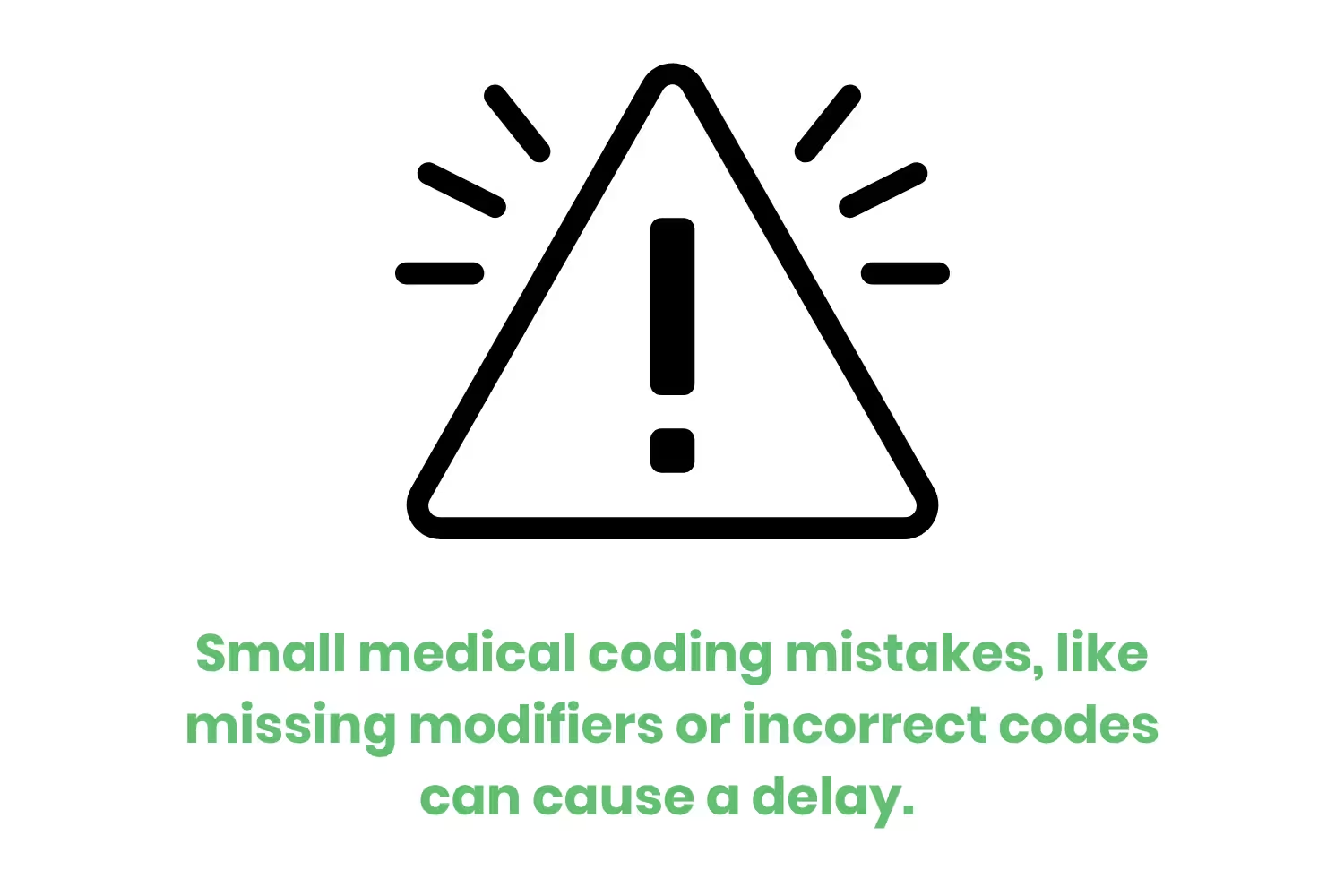
Insurance Companies Policies and Coverage Issues
Every payer maintains its own coverage policies and medical necessary rules, and they do not always align across carriers. When the submitted claim conflicts with the payer’s internal medical policy the system flags it as a non-covered service.
The payer is basically saying “ We acknowledge you performed the specific service, but under the rules, we can not pay for it.” This is why understanding your patients' coverage is vital to understand before performing services.
How to Address CO 96 Denial Codes
You can not completely avoid this denial code, so what happens if your organization receives it? These denials don’t always mean the service was performed incorrectly, they often point to coverage issues, missing details, or coding mismatches
These errors will occur during the billing and coding process, ensuring close coordination with teams can help reduce these silly denials. The key is to act quickly,identify the reason for the denial, and fix the problem before resubmitting the claim. Here’s how your billing team can take an organized approach to resolving CO-96 denials and recovering payment. Your team understanding this step-by-step billing process helps improve turnaround times.
Steps to Resubmit the Claim
Identify what is wrong
The first thing your team should do when receiving the denial code is review the denial code itself and the original claim. Your team should also be reviewing the Explanation of Benefits, helping outline the payers reasoning for the denial. This can help you initially identify the specific reason for the code and try to find where in the claim it occurred.
Your team should also be checking the documentation on record and the patient's insurance policy itself. These two resources paired with the denial code and claim will make it easier for your team to identify the error. Together clarifying whether the claim was denied due to coverage limitations, coding errors, or missing documentation.
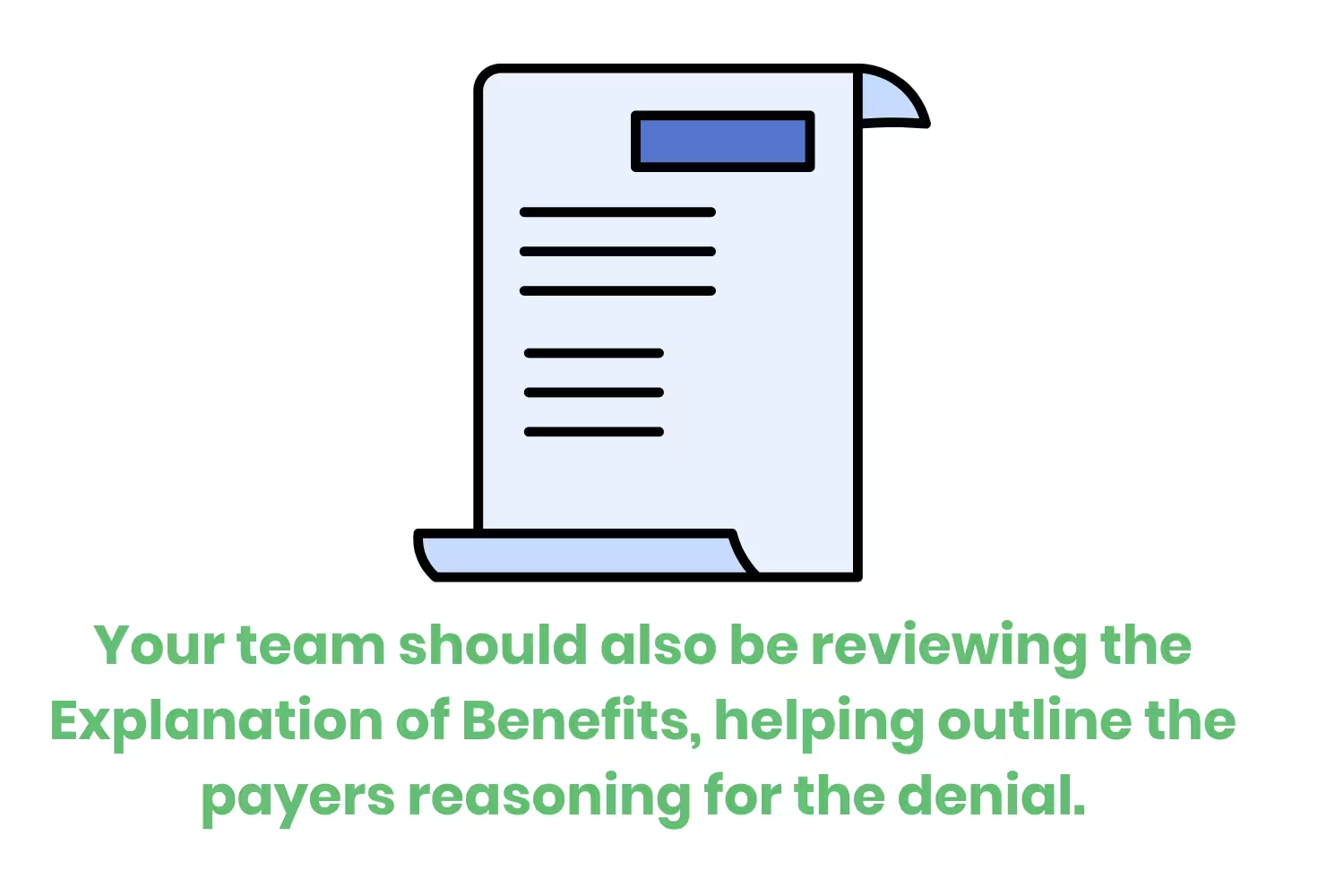
Take Corrective Action
Once the error has been identified, your team should start trying to resolve the error in a timely manner.
Correcting the claim can take many forms, your team can:
- Correct the Code itself
- Correct any modifiers
- Update documentation to support that the service was medically necessary.
- Update Eligibility information to prove the patient eligible for the service.
- Add prior authorization numbers that occurred before the service.
When your team is positive that the claim has been corrected, the next step is to resubmit the claim.
Resubmit the Corrected Claim
If your team finds an error, it is important to start correcting the claim as soon as possible. Starting this process immediately is important because insurance companies have a timeframe on when the corrected claim is to be resubmitted.
Even if your billing team corrects the claim, if it is after the set timeframe, it will be automatically denied again, this is why timely claim submission is so critical.
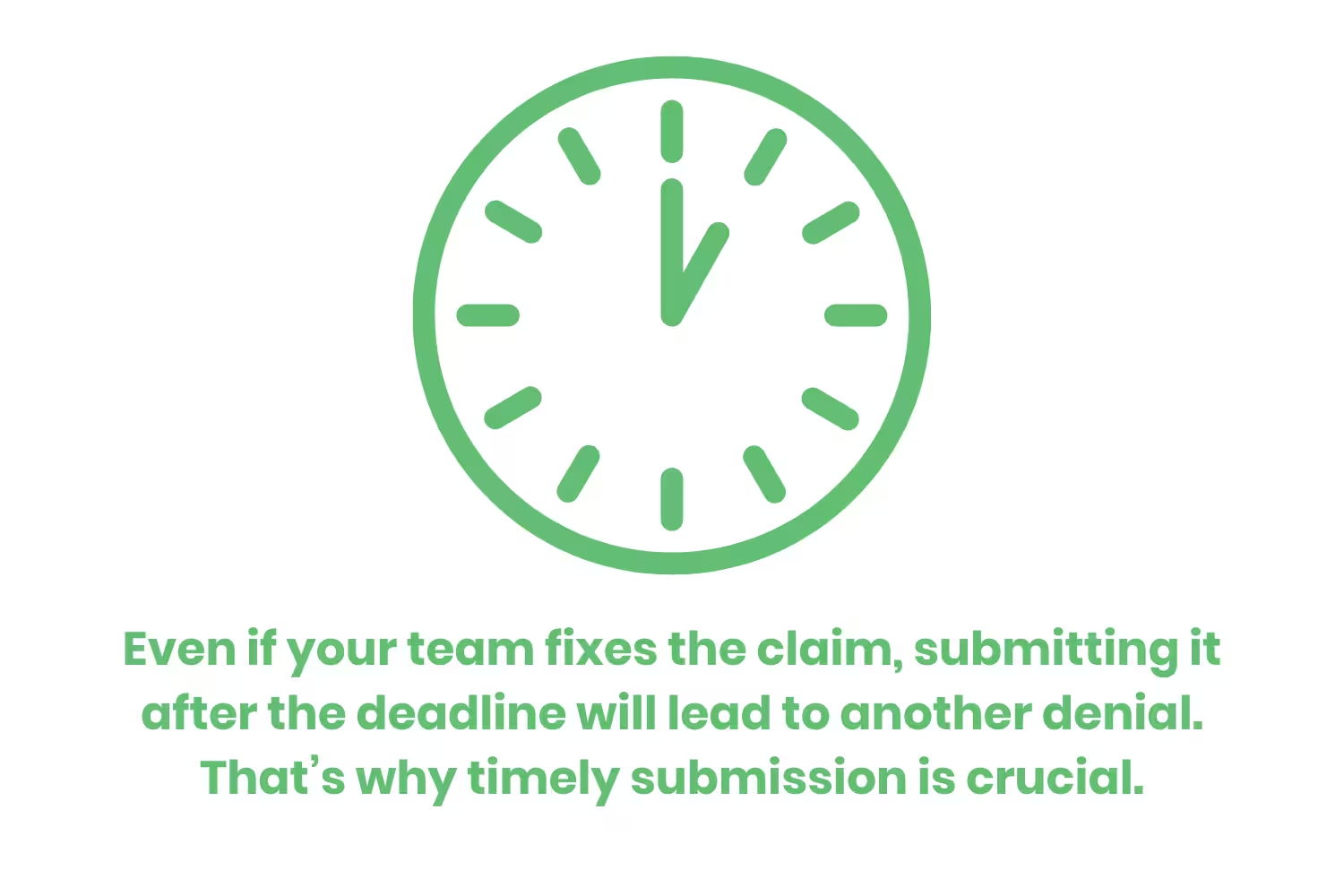
Submit an Appeal if Necessary
Now, what if your team reviews the claim and finds no errors at all? The next step for your team is to file an appeal with the insurance company. When filling an appeal your organization needs to ensure they have proper documentation to prove that the original claim is correct.
It is also important to note that every insurance provider has a different time frame in which the appeal is to be filled by. If the billing department files the appeal after that timeframe the claim will remain denied, even if there's proof proving that the claim was error free.
Conclusion
Receiving any denial codes can be frustrating, but it can be especially frustrating when they are easily avoidable. Training your department to understand why the denial happens is the first step in avoiding them all together. Whether that's by consistent training, clearinghouses, or continuous checking on payer policies is an important step.
Even if your team receives a denial code it is important to not get too frustrated as mistakes happen. Having a detailed plan on their next steps can help your department run smoothly, resubmitting claims as soon as possible.
Emphasize your product's unique features or benefits to differentiate it from competitors
In nec dictum adipiscing pharetra enim etiam scelerisque dolor purus ipsum egestas cursus vulputate arcu egestas ut eu sed mollis consectetur mattis pharetra curabitur et maecenas in mattis fames consectetur ipsum quis risus mauris aliquam ornare nisl purus at ipsum nulla accumsan consectetur vestibulum suspendisse aliquam condimentum scelerisque lacinia pellentesque vestibulum condimentum turpis ligula pharetra dictum sapien facilisis sapien at sagittis et cursus congue.
- Pharetra curabitur et maecenas in mattis fames consectetur ipsum quis risus.
- Justo urna nisi auctor consequat consectetur dolor lectus blandit.
- Eget egestas volutpat lacinia vestibulum vitae mattis hendrerit.
- Ornare elit odio tellus orci bibendum dictum id sem congue enim amet diam.
Incorporate statistics or specific numbers to highlight the effectiveness or popularity of your offering
Convallis pellentesque ullamcorper sapien sed tristique fermentum proin amet quam tincidunt feugiat vitae neque quisque odio ut pellentesque ac mauris eget lectus. Pretium arcu turpis lacus sapien sit at eu sapien duis magna nunc nibh nam non ut nibh ultrices ultrices elementum egestas enim nisl sed cursus pellentesque sit dignissim enim euismod sit et convallis sed pelis viverra quam at nisl sit pharetra enim nisl nec vestibulum posuere in volutpat sed blandit neque risus.

Use time-sensitive language to encourage immediate action, such as "Limited Time Offer
Feugiat vitae neque quisque odio ut pellentesque ac mauris eget lectus. Pretium arcu turpis lacus sapien sit at eu sapien duis magna nunc nibh nam non ut nibh ultrices ultrices elementum egestas enim nisl sed cursus pellentesque sit dignissim enim euismod sit et convallis sed pelis viverra quam at nisl sit pharetra enim nisl nec vestibulum posuere in volutpat sed blandit neque risus.
- Pharetra curabitur et maecenas in mattis fames consectetur ipsum quis risus.
- Justo urna nisi auctor consequat consectetur dolor lectus blandit.
- Eget egestas volutpat lacinia vestibulum vitae mattis hendrerit.
- Ornare elit odio tellus orci bibendum dictum id sem congue enim amet diam.
Address customer pain points directly by showing how your product solves their problems
Feugiat vitae neque quisque odio ut pellentesque ac mauris eget lectus. Pretium arcu turpis lacus sapien sit at eu sapien duis magna nunc nibh nam non ut nibh ultrices ultrices elementum egestas enim nisl sed cursus pellentesque sit dignissim enim euismod sit et convallis sed pelis viverra quam at nisl sit pharetra enim nisl nec vestibulum posuere in volutpat sed blandit neque risus.
Vel etiam vel amet aenean eget in habitasse nunc duis tellus sem turpis risus aliquam ac volutpat tellus eu faucibus ullamcorper.
Tailor titles to your ideal customer segment using phrases like "Designed for Busy Professionals
Sed pretium id nibh id sit felis vitae volutpat volutpat adipiscing at sodales neque lectus mi phasellus commodo at elit suspendisse ornare faucibus lectus purus viverra in nec aliquet commodo et sed sed nisi tempor mi pellentesque arcu viverra pretium duis enim vulputate dignissim etiam ultrices vitae neque urna proin nibh diam turpis augue lacus.




